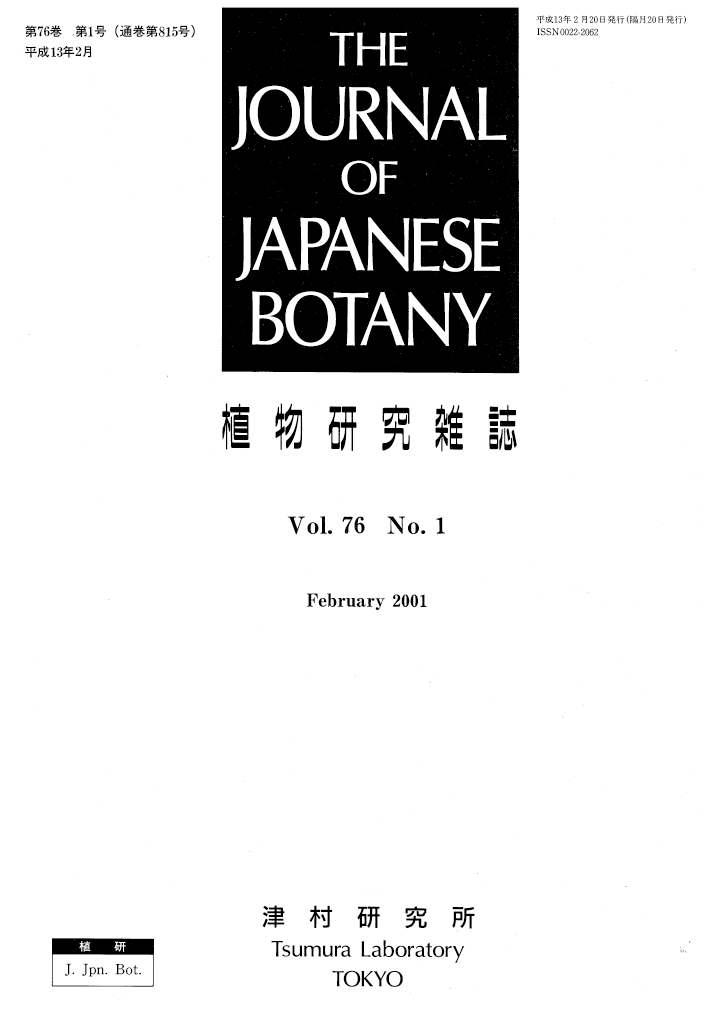
- |<
- <
- 1
- >
- >|
-
Article type: cover
2001Volume 76Issue 1 Article ID: 76_1_9476
Published: February 20, 2001
Released on J-STAGE: October 21, 2022
JOURNAL FREE ACCESSDownload PDF (217K) -
Per M. JORGENSEN, Hiroyuki KASHIWADANIArticle type: Originals
2001Volume 76Issue 1 Pages 1-10
Published: February 20, 2001
Released on J-STAGE: October 21, 2022
JOURNAL FREE ACCESSJapanese species of the lichen genus Pannaria were revised. A new species in the P. rubiginosa group, P. asahinae P.M.Jørg. was described. P. globuligera Hue and P. insularis P.M.Jørg. & Kashiw., sp. nov. in the P. lurida group were recognized. A key is given to the sorediate/isidiate taxa recognized at present. Only material of P. lurida from meridional Japan belongs to subsp. lurida, whereas that from Hokkaido and northern Honshu belongs to subsp. russellii (Tuck.) P.M.Jørg., though often containing pannarin. P. tavaresii P.M.Jørg. is recorded as new to Japan. The term gymnidium is introduced for the special ecorticate lobules found on P. globuligera and several other species of the Pannariaceae. All names are typified when necessary.
View full abstractDownload PDF (1042K) -
Noriyuki TANAKAArticle type: Originals
2001Volume 76Issue 1 Pages 11-19
Published: February 20, 2001
Released on J-STAGE: October 21, 2022
JOURNAL FREE ACCESSOphiopogon confertifolius N. Tanaka is described as new from the Malay Peninsula, Thailand. This species resembles O. fooningensis F.T.Wang & L.K.Dai from Yunnan (China), but differs from it in the number of leaves, the relative length of bracts to flowers, and the colour of flowers. A new variety, O. platyphyllus Merr. & Chun var. hayatae N.Tanaka, is described from northern Vietnam. This variety differs from var. platyphyllus chiefly by the pedicels articulate in the upper part. No confirmatory evidence has been obtained for the spontaneous occurrence of O. japonicus (Thunb.) Ker Gawl. in southern Asia (excluding China). A key to the 17 species of this genus hitherto recognized in this series of research is provided.
View full abstractDownload PDF (846K) -
Yuichi KADOTAArticle type: Originals
2001Volume 76Issue 1 Pages 20-27
Published: February 20, 2001
Released on J-STAGE: October 21, 2022
JOURNAL FREE ACCESSA new species and a new form of the genus Aconitum subgenus Lycoctonum are described from Hokkaido, Japan. Aconitum mashikense, an endemic of the Mashike and the Kabato Mountains, central Hokkaido, is characterized by pedicels golden villose with rough-surfaced patent hairs and linear bracteoles situated near the base of the pedicels. Aconitum gigas f. bicolor characterized by two-tone sepals is reported from southern Hokkaido.
View full abstractDownload PDF (1081K) -
Takasi YAMAZAKIArticle type: Originals
2001Volume 76Issue 1 Pages 28-30
Published: February 20, 2001
Released on J-STAGE: October 21, 2022
JOURNAL FREE ACCESSA new species, Mussaendopsis malayana Yamazaki, is dscribed from the Malay Peninsula. This is the fourth species in the genus.
View full abstractDownload PDF (281K) -
Hiroo KANAIArticle type: Originals
2001Volume 76Issue 1 Pages 31-49
Published: February 20, 2001
Released on J-STAGE: October 21, 2022
JOURNAL FREE ACCESSDistribution of 31 popular plants (Tab. 1 and Figs. 2-16) in Yamaguchi Prefecture, Chugoku District, western Japan was surveyed (Fig. 1) in cooperation with local botanists. Reynoutria sachalinensis was not detected. Humulus japonicus and Portulaca oleracea were restricted to lowland. Macleaya cordata, Adenocaulon himalaicum and Kerria japonica were restricted to hill region. Youngia denticulata and Cayratia japonica occupied lowland with some advance into hill region.
View full abstractDownload PDF (1096K) -
P. M. JORGENSENArticle type: Notes
2001Volume 76Issue 1 Pages 50-51
Published: February 20, 2001
Released on J-STAGE: October 21, 2022
JOURNAL FREE ACCESSDownload PDF (182K) -
Takahide KUROSAWAArticle type: Notes
2001Volume 76Issue 1 Pages 51-52
Published: February 20, 2001
Released on J-STAGE: October 21, 2022
JOURNAL FREE ACCESSDownload PDF (155K) -
Hiroo KANAIArticle type: Notes
2001Volume 76Issue 1 Pages 53-54
Published: February 20, 2001
Released on J-STAGE: October 21, 2022
JOURNAL FREE ACCESSDownload PDF (201K) -
Hiroo KANAIArticle type: Notes
2001Volume 76Issue 1 Pages 54-56
Published: February 20, 2001
Released on J-STAGE: October 21, 2022
JOURNAL FREE ACCESSDownload PDF (317K) -
Hiroo KANAIArticle type: Obituary
2001Volume 76Issue 1 Pages 56-58
Published: February 20, 2001
Released on J-STAGE: October 21, 2022
JOURNAL FREE ACCESSDownload PDF (251K) -
[in Japanese]Article type: Book review
2001Volume 76Issue 1 Pages 58
Published: February 20, 2001
Released on J-STAGE: October 21, 2022
JOURNAL FREE ACCESSDownload PDF (67K) -
[in Japanese]Article type: Book review
2001Volume 76Issue 1 Pages 58
Published: February 20, 2001
Released on J-STAGE: October 21, 2022
JOURNAL FREE ACCESSDownload PDF (67K) -
Article type: Instructions to authors
2001Volume 76Issue 1 Article ID: 76_1_9489
Published: February 20, 2001
Released on J-STAGE: October 21, 2022
JOURNAL FREE ACCESSDownload PDF (172K)
- |<
- <
- 1
- >
- >|